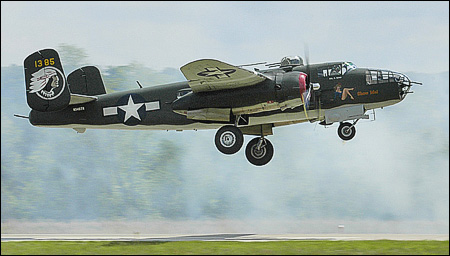Entrenamiento en el Lago Murray y recuperación del B-25C
El entrenamiento de los despegues en pistas cortas (de la misma longitud que las cubiertas de los portaviones) se realizó sobre el Lago Murray, en el Condado de Lexington, pero fueron llevados a cabo después de la misión de Doolittle.
Con las tripulaciones inexpertas se sucedieron los accidentes en el lago durante 1943 cayendo al agua varios B-25. Los registros indican que al menos cinco B-25 cayeron al agua de los que al menos se recuperaron tres en su época y uno permanecía oculto bajo las oscuras aguas. El otro que permanecía bajo las aguas era un B-25C (112634) que chocó contra el agua el 4 abril de 1943 al sufrir una avería en su motor izquierdo. Fue localizado un grupo privado dirigidos por Dr. Robert Seigler a 150 píes de profundida. A pesar de haber chocado contra el agua el bombardero se encontraba en buenas condiciones sobre el fondo. El motor del ala derecha se había desprendido por el choque pero el fuselaje estaba prácticamente intacto con el numeral “41-12634” aún visible en la deriva de su cola. Actualmente, este avión está bajo la jurisdicción del Instituto de Carolina del Sur de Arqueología y Antropología (SCIAA). El rescate se coordinó entre el Dr. Seigler, el SCE&G y Gary Larkins en septiembre de 2005.
Localización del B-25
El Proyecto del rescate del B-25 del Lago Murray fue organizado por el Dr. Seigler junto con un variopinto grupo de profesionales (Bill Vartorella, John Hodge, etc) en el año 1994. Sin embargo la idea le rondaba ya la cabeza desde 1980 inspirado en la obra de Coy Bayne “Lake Murray: Legends and Leisure” escrita en 1973. El proyecto recibió el nombre de “B-25 Bomber, the B-25 Rescue Project, Lake Murray, SC”.
El B-25 descansando en el fondo del lago
De los casi 10.000 B-25 fabricados hoy en día quedan unos 130 y el que se recató del Lago Murray es el tercero más antiguo, solo quedan cuatro B-25C. Actualmente su sección delantera se encuentra en el Museo de Vuelo de Birmingham, Alabama. El B-25 se conserva tal y como fue rescatado pues el director del museo, Jim Griffin, estimó que el coste de la restauración sería muy elevado.
Después de casi 70 años, el B-25 está a punto de ver la luz
Los trabajos de extracción de los restos se prologaron hasta la caída de la noche.
El B-25 ya en la orilla. Nótese la ausencia del motor del ala deracha
English version
The training of takeoffs on short tracks (of the same length as the decks of aircraft carriers) was held on Lake Murray, Lexington County, but were carried out after the Doolittle mission.
With inexperienced crews accidents occurred during 1943 in the lake water falling several B-25. Records indicate that at least five B-25 fell into the water of which at least three recovered at the time and one remained hidden beneath the dark waters. The other remaining under water was a B-25C (112 634) that crashed into the water on April 4, 1943 after suffering a breakdown in its left engine. It was located a private group led by Dr. Robert Seigler to 150 feet deep. Although he hit the water bomber was in good condition on the merits. The right-wing engine had been detached by the shock but the fuselage was largely intact with the numeral "41-12634" still visible in the drift of his tail. Currently, this aircraft is under the jurisdiction of the South Carolina Institute of Archaeology and Anthropology (SCIA). The rescue was coordinated between Dr. Seigler, the SCE & G and Gary Larkins in September 2005.
Rescue Project B-25 from Lake Murray was organized by Dr. Seigler along with a diverse group of professionals (Bill Vartorella, John Hodge, etc) in 1994. However, the idea haunted him since 1980 and head inspired by the work of Coy Bayne "Lake Murray: Legends and Leisure" written in 1973. The project was called "B-25 Bomber, the B-25 Rescue Project, Lake Murray, SC".
Of the nearly 10,000 B-25 manufactured today are about 130 and that modesty of Lake Murray is the third oldest, there are only four B-25C. Currently its forward section is in the Museum of Flight in Birmingham, Alabama. The B-25 is preserved as it was rescued for the museum's director, Jim Griffin, estimated that the cost of restoration would be very high.
The numeral of the unit, still visible in the drift of the tail.
Link
Columbia Star










No hay comentarios:
Publicar un comentario